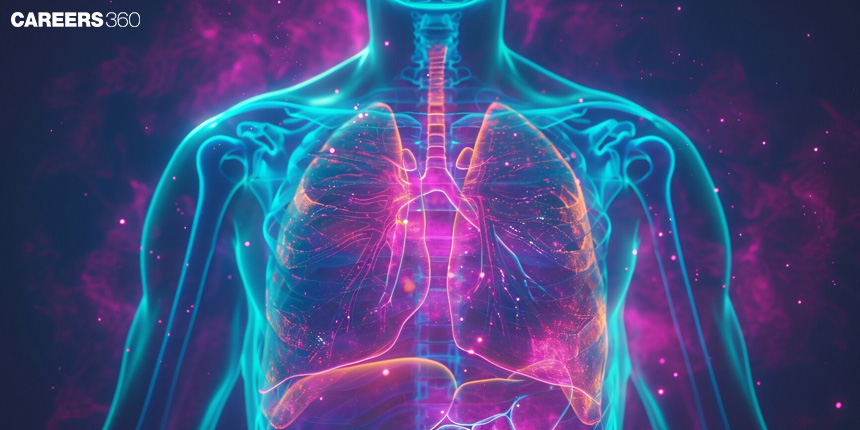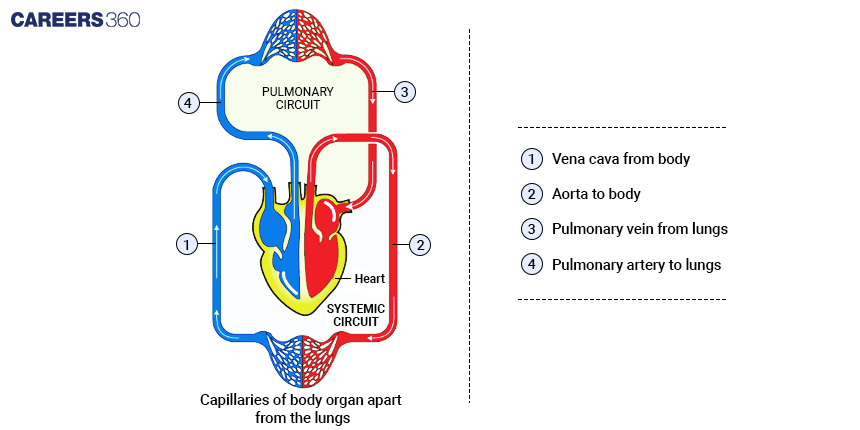How Does The Circulatory System Work: Diagram, Steps, Function
The circulatory system, also known as the cardiovascular system, is responsible for transporting nutrients, oxygen, hormones, and waste products throughout the body. It consists of the heart, blood vessels, and blood working together to maintain homeostasis and support vital functions. In this article, the circulatory system, components of the circulatory system, functions of the circulatory system, mechanisms controlling the circulatory system, disorders of the circulatory system, and need of the circulatory system are discussed. The circulatory system is a topic of the chapter Body Fluids and Circulation in Biology.
Don't Miss: Most scoring concepts for NEET | NEET papers with solutions
NEET 2025: Syllabus | PYQs | Crack NEET in 2 months - Study Plan
NEET Important PYQ & Solutions: Physics | Chemistry | Biology | NEET PYQ's (2015-24)
- What is a Circulatory System?
- Components of the Circulatory System
- Functions of the Circulatory System
- Mechanisms Controlling Circulatory System
- Need of the Circulatory System
- Disorders of the Circulatory System
- Recommended Video On How Does The Circulatory System Work

What is a Circulatory System?
The circulatory system is also called the cardiovascular system. It is a complex network of the heart, blood, and blood vessels. It aims to transport oxygen, nutrients, hormones, and cellular waste throughout the body. The circulatory system ensures the delivery of needs for every cell to live and function well and, ultimately, the removal of metabolic waste that may be detrimental to the then operation of a cell.
It regulates all human physiological functions such as body temperature, pH levels, and fluid balance in the body for homeostasis. The body is prone to diseases and other serious problems if the circulatory system fails. Since the normal function of the circulatory system is important for a human being's health, it is part of the immune response and aids in the repair of tissues and, in general, the vitality, and well-being of an individual.
Components of the Circulatory System
The vertebrate circulatory system is constituted by basically the main parts that provide for blood flow within the complete human body.
Heart
There are four chambers, two atria (upper chambers) and two ventricles (lower chambers).
These chambers provide space for four valves—the tricuspid, pulmonary, mitral, and aortic which are used to control the flow of blood.
The heart is a pump that pushes blood into the circulatory system.
The blood is pushed to transport oxygen and nutrients to the tissues and, in turn, remove waste products.
Blood Vessels
Arteries carry oxygenated blood from the heart. Veins carry deoxygenated blood back to the heart.
Capillaries allow gas exchange, the exchange of nutrients at the tissue level, and the elimination of wastes in the blood.
The arteries are endowed with various muscles which can withstand high pressure.
Veins have numerous valves to prevent backflow.
Capillaries are thin-walled to allow easy exchange of substances.
Blood
The four components of blood are red blood cells, white blood cells, platelets, and plasma.
Red blood cells are known for the transport of oxygen,
White blood cells act as infection-fighting agents.
Platelets contain the clotting mechanism of blood, and plasma is for carrying nutrients, some hormones, and waste, alongside water.

Also Read-
Functions of the Circulatory System
The circulatory system performs activity through the interaction of many interwoven paths to move blood and, thus, oxygen from the lungs to the various tissues of the body.
Pulmonary Circulation
Blood, which is deoxygenated, is pumped from the right ventricle into the lungs through the pulmonary arteries.
In the lungs, blood is oxygenated, and from there, it enters the left atrium through the pulmonary veins.
Carbon dioxide is exchanged for oxygen and this oxygen binds with the hemoglobin present in red blood cells.
Systemic Circulation
The oxygen-rich blood from the left ventricle is pumped away through the aorta to the general body circulation, where the oxygen and nutrients are provided to cells.
Deoxygenated blood, full of waste products, returns to the heart through veins, and the systemic circuit is completed.
Coronary Circulation
The coronary arteries supply oxygenated blood to the heart muscle, which the heart cannot do without to work well.
Adequate coronary circulation is thus needed to prevent ischemic conditions, such as those of heart attack.
Mechanisms Controlling Circulatory System
Several mechanisms take part in controlling the circulatory system so that it works properly or adjusts to the requirements of the body.
Heart Rate and Cardiac Output
Stress, exercise, hormones, and autonomic nervous system inputs are a few stimuli that can increase or decrease heart rate.
The volume of blood pumped by the heart in one minute is the cardiac output, and it is a key driver of the overall metabolic demand for oxygen from all the tissues in the body.
Blood Pressure Regulation
The pressure exerted by blood on the walls of the arteries during systole is called systolic pressure, and the measure of the force when the heart relaxes is diastolic pressure.
The autonomic nervous system is responsible for regulating the diameter of the blood vessels and the heart rate in response to appropriate stimuli to supply the heart with blood.
Homeostatic Mechanisms
Regulation of blood volume and blood pressure is a function of the kidneys not independent of renal function.
The long-term regulation of blood pressure is integrally related to the control of the balance of the body's fluids and electrolytes.
Various sensors and effectors within the body affect the circulatory parameters, leading to homeostasis.
Need of the Circulatory System
The cells, tissues, organs, and organ systems make up the majority of the human body. All of them depend on specific vital elements and components, which are transported by the circulatory system, to continue their metabolic processes and maintain the health of our bodies.
The digestive system
Nutrients that have been broken down and absorbed from food molecules are transported to every body cell by the circulatory system.
The respiratory system
The movement of oxygen from the lungs to every area of the body is facilitated by the circulatory system. Similar to this, carbon dioxide is drawn from the various cells and tissues and sent to the lungs, where it is expelled through the nostrils into the surrounding air.
Mechanism of excretion
All waste products generated by the cells, tissues, and other organs during their metabolic processes, including excess water, salts, nitrogenous wastes, urea, and others, are transported to the excretory system and expelled from the body via the appropriate excretory organs.
The endocrine system
The specialised glands that produce hormones to control growth, development, metabolism, and other cellular processes are part of the endocrine system. Transporting released hormones throughout the body or to the intended locations is a function of the circulatory system.
Disorders of the Circulatory System
The derangements in the circulatory system may seriously impact overall health, so an apt approach to prevention and management is required.
Common Disorders
Hypertension: Sustained higher-than-normal pressure, threatening damage to blood vessels and organs.
Atherosclerosis: Fatty plaque deposition within arteries, which leads to reduced blood supply.
Heart Attack: Obstruction of coronary arteries; subsequently, occlusion of the heart's muscle.
Stroke: The interruption of blood flow to the brain resulting in neurological damage.
Prevention And Management
Healthy eating, exercise, and abstaining from smoking and overconsumption of alcohol may prevent circulatory disorders.
Medications to lower blood pressure and cholesterol, and surgical procedures such as angioplasty are used to treat and manage circulatory system disorders.
Also Read-
| Facts about Blood | Facts about Blood Group |
| Types of Blood Cells | Blood coagulation |
| ABO Blood Group | Circulatory System |
Recommended Video On How Does The Circulatory System Work
Frequently Asked Questions (FAQs)
It is the process involved in the transportation of blood, nutrients, gases, and excretory products to and from all cells of the body.
Blood flows in this sequence throughout the heart: In the right atrium, into the right ventricle, to the lungs where it picks up oxygen, back to the left atrium, and then out to the body from the left ventricle.
Arteries carry blood away from the heart, veins carry blood towards the heart, and capillaries are small vessels where the exchange of substances occurs between blood and tissues.
Blood pressure is regulated by the autonomic nervous system, hormones, and kidneys through various feedback mechanisms that adjust heart rate, blood vessel diameter, and blood volume.
Characteristics of the disorders in the circulatory system are hypertension, atherosclerosis, heart attacks, and strokes.
Also Read
29 Nov'24 01:19 PM
27 Nov'24 07:39 PM
27 Nov'24 07:15 PM
27 Nov'24 05:11 PM
26 Nov'24 08:14 PM
26 Nov'24 06:50 PM
26 Nov'24 05:51 PM
26 Nov'24 04:44 PM
26 Nov'24 03:52 PM
26 Nov'24 02:55 PM